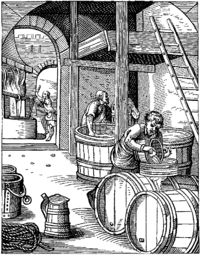
Photo from wikipedia
BACKGROUND Foaming properties and macromolecular interactions in solution among brewer's spent grain proteins (CP) and iota and lambda carrageenans (i-CG and l-CG, respectively) as a function of aqueous medium pH… Click to show full abstract
BACKGROUND Foaming properties and macromolecular interactions in solution among brewer's spent grain proteins (CP) and iota and lambda carrageenans (i-CG and l-CG, respectively) as a function of aqueous medium pH (2-6) and protein-polysaccharide ratio-RCP:CG (1:1, 2:1, and 4:1) were studied. At these conditions, the CP colloidal stability was favored by the formation of soluble electrostatic complexes with CG. Fluorescence (intrinsic and extrinsic) spectroscopy and dynamic light scattering (DLS) techniques, including particle size and ζ-potential analysis, were applied to know the phase behavior of the biopolymer systems. The bubbling method was used to produce foams, and the foam expansion (%) and half-life time (t1/2 ) were determined. RESULTS Both CG promoted an increased Trp fluorescence emission depending on the pH, suggesting conformational changes in CP. The CG in mixed systems produced a significant decrease in the extrinsic fluorescence intensity, mainly at low pH values, highlighting a reduction in CP surface hydrophobicity. At the examined pH range, the ζ-potential values for mixed-systems were negative, and their magnitudes were intermediate between CP and CG, revealing the associative electrostatic nature of biopolymer interactions, which were dependent on the RCP:CG . The particle size analysis confirmed the formation of soluble electrostatic complexes in solution. Finally, by using i-CG at pH 2 or 3 and 2:1 RCP:CG , the best foaming properties for mixed systems were observed. CONCLUSION The formation of electrostatic complexes with a compact assembly among biopolymers, high negative net charge, and colloidal stability convert the CP-CG mixed solutions into promising biopolymer systems for food foams production. This article is protected by copyright. All rights reserved.
Journal Title: Journal of the science of food and agriculture
Year Published: 2022
Link to full text (if available)
Share on Social Media: Sign Up to like & get
recommendations!